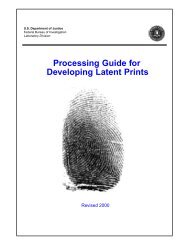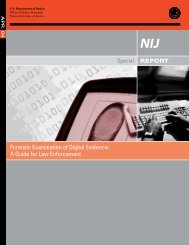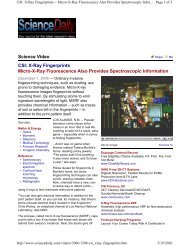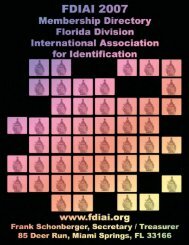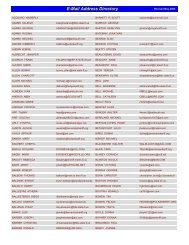scientific working group on imaging technologies (swgit) - the FDIAI
scientific working group on imaging technologies (swgit) - the FDIAI
scientific working group on imaging technologies (swgit) - the FDIAI
Create successful ePaper yourself
Turn your PDF publications into a flip-book with our unique Google optimized e-Paper software.
Categories of Training<br />
Several categories of <strong>imaging</strong> technology training relevant to <strong>the</strong> criminal justice system<br />
are identified below.<br />
a. Awareness<br />
Training designed to provide <strong>the</strong> student with a general knowledge of <strong>the</strong><br />
major elements of a given <strong>imaging</strong> technology, to include specific product<br />
capabilities.<br />
b. Skills and techniques<br />
Training designed to provide <strong>the</strong> student with <strong>the</strong> ability to competently use<br />
specific <strong>imaging</strong> equipment.<br />
c. Knowledge of processes and relati<strong>on</strong>ships<br />
Training designed to provide <strong>the</strong> student with an understanding of <strong>the</strong> <strong>imaging</strong><br />
technology and <strong>the</strong> ability to apply that technology to various applicati<strong>on</strong>s.<br />
d. Court procedures – witness testim<strong>on</strong>y<br />
Training designed to provide <strong>the</strong> student with <strong>the</strong> ability to present reliable<br />
<strong>imaging</strong> technology-based testim<strong>on</strong>y in court.<br />
e. Court procedures – case preparati<strong>on</strong><br />
Training designed to provide <strong>the</strong> student with <strong>the</strong> ability to prepare and review<br />
accurate and reliable <strong>imaging</strong> technology-based evidence.<br />
f. C<strong>on</strong>tinuing educati<strong>on</strong><br />
Training designed to provide <strong>the</strong> student with additi<strong>on</strong>al and updated training<br />
in <strong>imaging</strong> <strong>technologies</strong>.<br />
g. Specialized applicati<strong>on</strong>s<br />
Training in specific disciplines or in specialized areas.<br />
h. Proficiency<br />
Proficiency Training incorporates a number of comp<strong>on</strong>ents:<br />
1. Required levels of skill and knowledge for a job category should be<br />
identified by <strong>the</strong> agency. These levels should be driven by <strong>the</strong> requirements of<br />
<strong>the</strong> specific tasks to be accomplished.<br />
2. A course of study should be designed by <strong>the</strong> agency, or it’s agent, to<br />
provide <strong>the</strong> skills and informati<strong>on</strong> necessary for <strong>the</strong> agencies pers<strong>on</strong>nel to<br />
attain competency in those skills.<br />
3. If determined to be necessary by <strong>the</strong> agency, a proficiency test should be<br />
developed and administered to test proficiency in <strong>the</strong>se skills.<br />
4. Different levels of proficiency tests may be developed depending <strong>on</strong> <strong>the</strong><br />
level of skill and experience of <strong>the</strong> individual.



